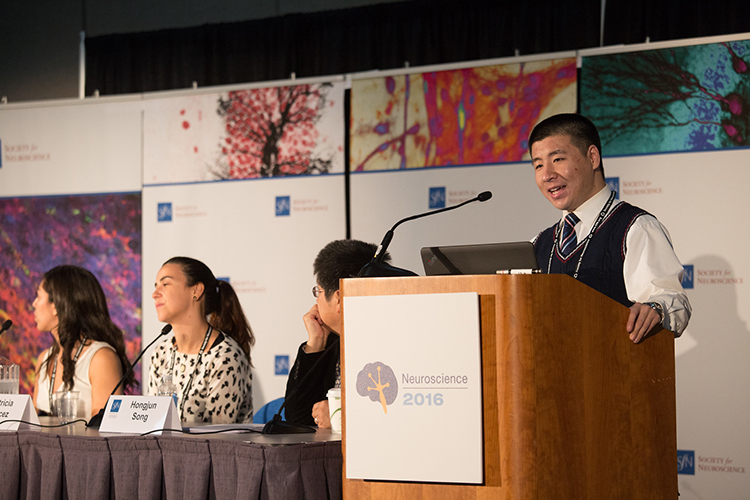
SfN Journals Grow to Advance the Field
SfN’s journals, eNeuro and JNeurosci, continue to provide the Society’s members and the field with two great options for publishing research. Each journal embraces its own distinct identity while staying true to SfN’s core values by advancing the field through the publication of high-quality, rigorous science.
eNeuro Grows Rapidly in Second Year
eNeuro, SfN’s open-access journal, showed even more impressive growth in its second year. A little over a year after its launch in November 2014, eNeuro published its 100th paper. By the end of its second year, the journal had published an additional 172 papers. By the beginning of 2017, eNeuro topped 300 published papers.
While the majority of these papers are original research articles, eNeuro has also published a number of significant commentaries, including two pieces of the importance of scientific rigor and one on communicating science to society.
The journal also tackled the issue of scientific rigor by joining the Research Resource Identification (RRID) Initiative, which allows scientists to clearly identify key resources used in the course of research, helping to address concerns about reproducibility. “RRIDs offer an important means for ensuring reproducible methods and providing critical data to help researchers identify suitable reagents and tools,” eNeuro Editor-in-Chief Christophe Bernard wrote when announcing the initiative.
As a young publication, eNeuro is not expected to get its first impact factor until 2018. Because some authors may be hesitant to publish in a journal without an impact factor, eNeuro authors can now request a letter of recommendation from SfN stating that the published science achieves the highest standards of quality. The authors can include this letter (signed by the reviewing editor of the paper, the advisory board member, and the editor-in-chief) in their CV to assist in their career progression.
“Given the high quality of the papers we have already published, and their number, you can be confident that eNeuro should be on top of your list of journals,” Bernard wrote in an editorial.
eNeuro’s editors have also made a concerted effort to inform authors, SfN members, and particularly early-career neuroscientists, about the intricacies of the peer-review process. These educational efforts include a webinar on how to peer review a manuscript with Advisory Board member Margaret McCarthy and a Q&A with Bernard on what you should know about being a reviewer and why it’s important for your career. Both of these resources can be found on Neuronline, and another webinar on how to review a computational analysis paper is planned for this spring.
JNeurosci Launches New Online Platform, Starts Early Release
JNeurosci, SfN’s flagship scientific publication, saw a bevy of changes in 2016, with new Editor-in-Chief Marina Picciotto taking the helm for a five-year term. She has made increased communication with authors and readers a priority, writing a monthly editorial to relay news and upcoming plans for JNeurosci.
The biggest changes Picciotto has overseen so far include the move last October to a new digital publishing platform (already in use by eNeuro) and the accompanying switch to online early-release publishing.
“Publishing articles online shortly after they are accepted will allow the neuroscience community access to new data as quickly as possible after the peer review process,” Picciotto explained in her editorial announcing the change.
Among the many innovations stemming from the new online platform is a refreshed website that makes it easier for visitors to navigate and access information, such as new alt-metrics and extended datasets. Alt-metrics now available include mentions on social media, how often the abstract, PDF, or online version of the article have been accessed, and the number of citations. In addition, the inclusion of extended datasets is important for transparency and reproducibility, allowing those who wish to replicate studies access to the data they need to build on the published work.
“We are excited that the migration to a new online platform will allow JNeurosci to provide our authors with new ways to present their scientific findings and to address issues related to timely dissemination of data and reproducibility,” Picciotto said.
JNeurosci also seeks to develop outlets for the discussion of neuroscience topics not being addressed elsewhere. JNeurosci intends to do this through several types of feature articles introduced in 2016:
- TechSights — an overview of technical developments in neuroscience
- Viewpoints — topical reviews that cover a current topic in neuroscience
- Dual Perspectives — pairs of short, expert mini-reviews that provide opposite and/or complementary hypotheses related to an important question in neuroscience
- Progressions — a “where are they now” of highly cited research published in JNeurosci to see how the science has progressed (the first article is expected to be published in February)
Finally, JNeurosci will implement a change to its submission fees later this winter. As an enhanced member benefit, the submission fee will be waived for SfN members. To receive the discount, both the first and last authors on the paper need to be SfN members. Meanwhile, the submission fee will become nonrefundable for nonmembers, even if the paper is rejected during the editorial process. Journal editors are encouraged to provide specific feedback as to why a paper is being rejected so the submission process remains valuable to all authors. JNeurosci is also conducting a webinar later this year on peer review in an effort to make the process more transparent for authors.
In a joint editorial last year, Picciotto and Bernard outlined their vision for SfN’s journals: “We anticipate that JNeurosci and eNeuro will continue to evolve, both by strategic decisions based on ongoing discussion between the editorial boards of the journals, and as a result of the natural evolution that occurs as authors choose where to submit their work. Both journals welcome input from the neuroscience community on how to provide options for publishing rigorous and insightful research, and on how these two Society for Neuroscience journals can best serve the field.”



















